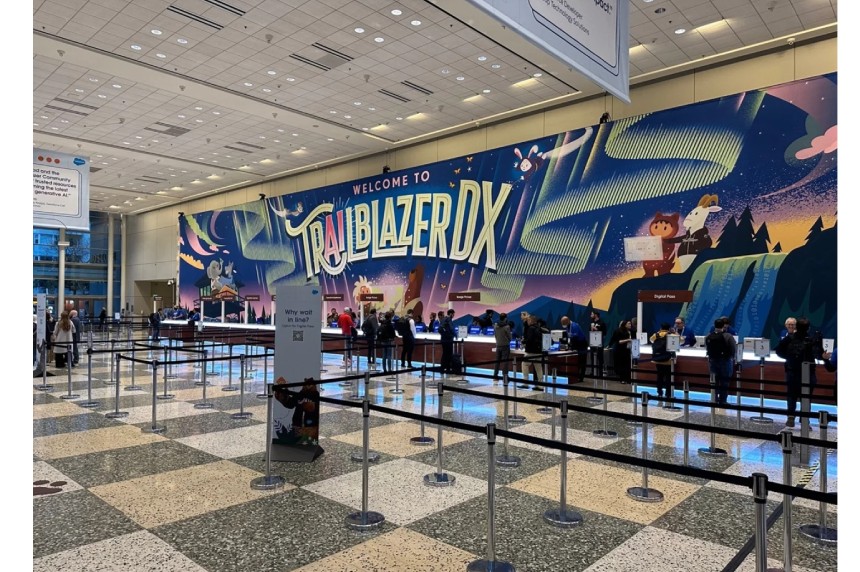Salesforce’s annual developer conference, TrailblazerDX, was held in San Francisco last month. This year, my main interests centered on new advancements in the Salesforce ecosystem, including AI, Data Cloud, MuleSoft, Salesforce’s Well-Architected Framework, and core functionality improvements such as setup. Below are my top five takeaways from the conference!
1. Einstein, Prompt Builder, and AI
As anticipated, the spotlight was on new features powered by Einstein’s generative AI capabilities. Salesforce continues to enhance AI tools to address real business challenges. The Einstein Prompt Builder allows Salesforce admins and developers to build processes for interacting with generative models like ChatGPT, utilizing specific data. For example, it can summarize product reviews or case data, providing executive summaries and ensuring human validation before storing them for future use.
Technologists using the Einstein Prompt Builder must know how to structure requests to generate optimal responses aligned with business needs.
2. Data Cloud
Salesforce Data Cloud is one of the ecosystem’s key growth areas, evolving from its original go-to-market as Salesforce CDP and Salesforce Genie. This powerful product integrates external customer data with Salesforce data, forming the foundation for many AI use cases. The focus has expanded beyond marketing to include any use case involving Salesforce’s data object model, with three key types: Profile (who—e.g., customer), Engagement (when—time-based activities like orders), and Other (what—data linked to Profile or Engagement, like products).
Recent enhancements to Data Cloud include zero-ETL integrations with Snowflake and improved data collection for predictive or generative AI use. Unlike MuleSoft and Tableau, which were acquired, Data Cloud is developed internally by Salesforce, offering tighter integration with core Salesforce functionality. This integration enables features like presenting Data Cloud data as a Related List on Salesforce objects like Account or Contact.
3. MuleSoft and Other Integration Technologies
MuleSoft remains a leader in seamless system integration. Just as Flow can trigger record updates in Salesforce, MuleSoft can automate actions across platforms, like sending a Slack message when a Salesforce record is updated.
MuleSoft integrates data across Salesforce and other systems. Additionally, tools built on MuleSoft, such as dataloader.io, support smaller organizations with data loading and extraction needs. Dataloader.io plans to extend support for database access, facilitating basic data loading use cases.
For those not using MuleSoft, Salesforce has enhanced Platform Events and Apex. These tools allow users to focus on no-code/low-code declarative methods first, with minimal code additions for specific needs. With Invocable Actions in Apex and enhanced Pub/Sub AI, users can scale to a more robust integration model.
4. Salesforce Well-Architected Patterns and Anti-Patterns
The Salesforce Well-Architected Pattern and Anti-Pattern Explorer uses core Salesforce concepts—trusted, easy, and adaptable—as frameworks for architecture decisions. The Well-Architected Framework provides tools and diagrams to communicate Salesforce architecture to both business and technical teams.
5. Salesforce Setup and Core User Enhancements
The Salesforce setup experience has become increasingly complex over time. There’s a clear focus on simplifying this experience in upcoming releases. Although Salesforce will not sunset Profile permissions next year, the recommended practice is to use a permission set-led model for secure and straightforward administration.
New features will help admins manage User Access Policies, clone users, and troubleshoot user access issues more effectively. Expect tools and reports that improve user access diagnostics to address common pain points.
Summary and Looking Ahead
TrailblazerDX offers an incredible opportunity to explore Salesforce’s new technology, connect with the Salesforce community, and get hands-on experience. This year’s event highlighted the transition of AI from hype to practical business applications, with Data Cloud centralizing customer data for AI-driven insights. Tools like MuleSoft and Platform Events integrate systems for cohesive solutions, while the Well-Architected Framework ensures trusted, adaptable Salesforce implementations. Enhancements in setup simplify administration and provide better control over new features.
The content from this year’s event is now available on Salesforce+, and the next TrailblazerDX will take place on March 5–6, 2025, in San Francisco and online.


